The cockroach hunter’s spell
For centuries, the jewel wasp has captivated entomologists with its beauty and, in the case of the female, its hunting prowess. The wasp doesn’t kill its prey right away. Instead, it injects a special venom into its cockroach victim, putting it into a bewitched state. The wasp then builds a burrow, drags in the zoned-out cockroach, lays an egg on it and buries it. The larva that emerges gradually eats the cockroach alive.
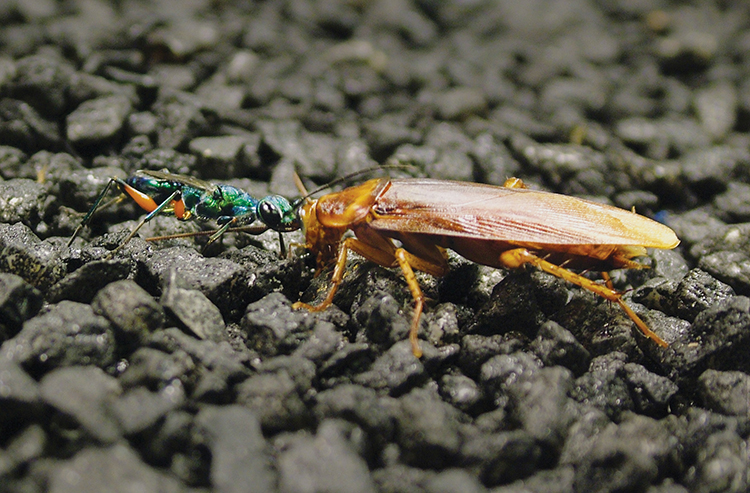 |
| Photos and video by Victor Landa, University of California, Riverside |
Over the past two decades, researchers have been trying to tease out the molecular composition of this unusual venom. Not only could the results help researchers understand how this venom acts on an animal’s central nervous system, but they also could lead to a better understanding of certain human neurological disorders that have some of the same symptoms as those found in the entranced cockroach.

The female Ampulex compressa and its taming of cockroaches were most vividly described in a 1942 paper by the entomologist Francis Xavier Williams.
“Ampulex compressa is a large, beautiful wasp with a shining blue-green body and with the femora or thighs of the second and third pairs of legs red … Mrs. Williams, who took great interest in this scintillating blue-green insect, very aptly named it the ‘jewel wasp.’”
But Williams knew that New Caledonia was one of the tropical homes of the jewel wasp. He saw this survey trip as an opportunity to bring the wasp to Hawaii and use the animal as roach control. He described the story of traveling with his wife to Noumea, the capital of New Caledonia, to bring back both male and female wasps to Hawaii.
“The jewel wasp puts up a wonderful exhibition of boldness, skill and strength in the attack on her often huge prey, once to the effect that a French scientist upon witnessing such a battle in our hotel room laboratory in New Caledonia, much impressed, exclaimed: ‘C’est formidable!’”

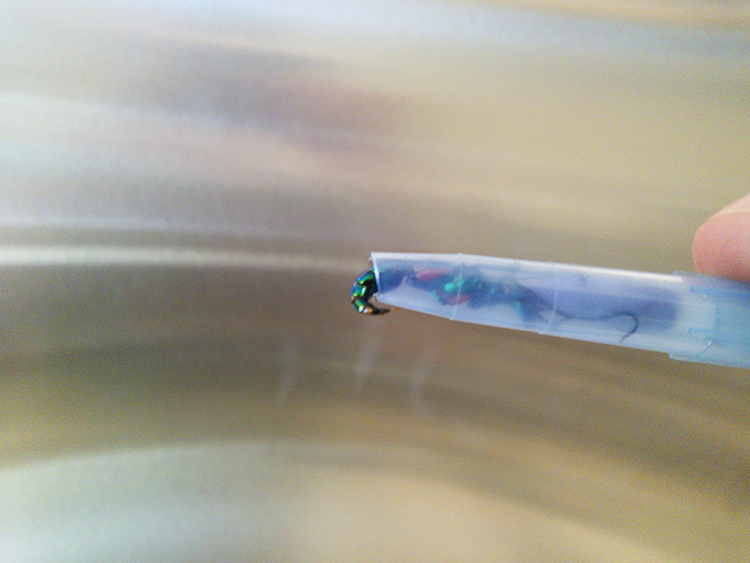 |
| Researchers place a wasp stinger-first into a pipet tip to extract its venom. |
At Hebrew University, Libersat met a visiting German scientist, Werner Rathmayer. Rathmayer was studying the bee wolf, a wasp that hunts bees, but he happened to have a jewel wasp in an aquarium in his office in Germany.
At that time, not much was known about how the female wasp managed to tame the cockroach. Given Libersat’s work on cockroaches, Rathmayer told him about the wasp and how it was capable of manipulating the cockroach’s central nervous system in mysterious ways. The wasp’s venom somehow made the cockroach unable to initiate walking on its own, putting it in a state known as hypokinesia. But when the wasp grabbed the cockroach by its antennae with its mandibles, it could lead the cockroach like a reined horse.
“I thought this would give me some window into understanding how walking is initiated in an insect, or any animal, as a matter of fact,” says Libersat, now at Ben Gurion University in Israel. Movement can be initiated by a stimulus, such as food, a sexual partner or scent. “But sometimes, an animal also initiates what’s called exploratory movement,” says Libersat. What causes animals to make these movements that don’t have clear-cut rewards?

The proteomic analysis
 |
| Arvidson |
If you’d like to learn more about wasp venom, check out Ryan Arvidson’s poster at the ASBMB annual meeting in San Diego. Arvidson will be presenting his poster, “Developing the venom of the parasitoid wasp Ampulex compressa,” between 12:15 p.m. and 1:45 p.m. on Monday, April 28, at poster board number D235. The abstract number is 4947. Photo provided by Ryan Arvidson.
Both groups have taken a proteomic sequencing approach. In collaboration with SongQin Pan, also at UC Riverside, Adams’ graduate student Ryan Arvidson used an approach called
multidimensional protein identification technology, better known by its acronym, MudPIT. This mass-spectrometric analysis is useful for studying complex protein mixtures.
The investigators earlier had built two databases of RNA sequences in collaboration with Peter Arensburger, now at the California Polytechnic State University, which they used for their MudPIT analyses to confirm that the protein identifications they made matched up with the transcripts in their databases.
To analyze wasp venom, one has to collect it. The approach is “artisanal,” jokes Libersat, whose group developed it. A researcher first stretches Parafilm across a Petri dish with a 5-µL droplet of water. Then he or she puts a female wasp in a pipette tip, abdomen first, so that the wasp’s stinger protrudes from the opening. The pipette tip then gets attached to a syringe. Then, as Arvidson delicately puts it, “we antagonize the wasp.”
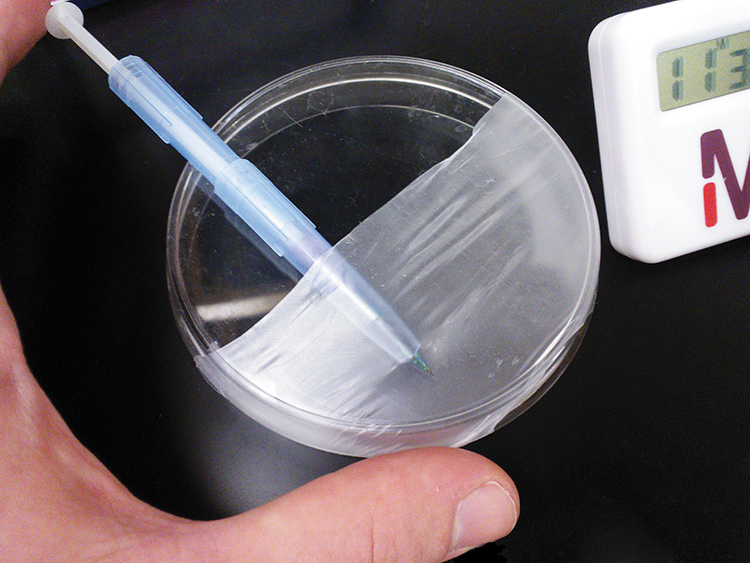 |
| A female Ampulex compressa releases 50 nL of venom in a single sting. |
Arvidson thinks they may have found peptides that are known to affect motor function. The investigators also have found some novel peptides: These peptides are present in the venom at particularly high concentrations and seem to be involved in inhibiting entry of calcium into neurons through a G-protein-coupled receptor pathway. “When we put the venom on cell culture, we see inhibition of calcium dynamics. We can talk a lot about how affecting calcium entry into a neuron can prevent it from firing, but as far as that leading to the hypokinesia, we haven’t made that connection yet,” says Adams.

 |
| The hunter scrutinizes its prey. |
“As a rule, Ampulex attacks the cockroach soon after the latter’s introduction into the jar. The wasp, then becoming very alert and with antennae directed towards her intended victim, approaches it from the side in front and with a short lightning leap… Immediately directing her flexible abdomen forward and underneath the cockroach’s thorax, she extends the point of her abdomen in search of a vital place in which to plunge her sting… The cockroach, now thoroughly frightened, struggles furiously, twisting, straining and describing short jerky circles, parrying with its legs, and striving particularly to tuck in its chin so that the tenaciously clinging wasp will not sting its throat.”
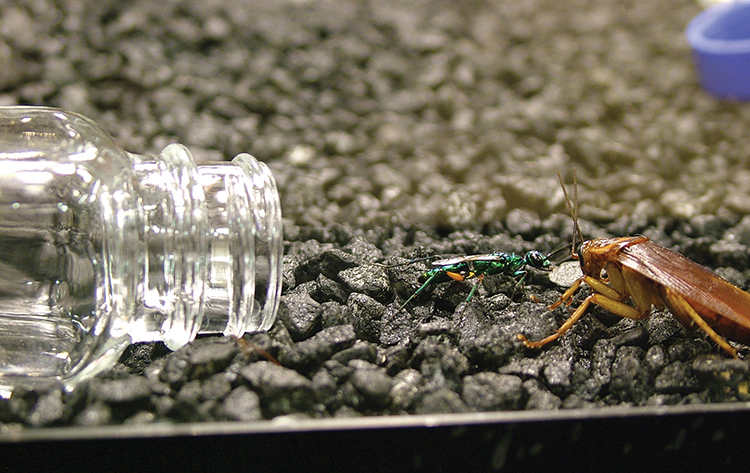 |
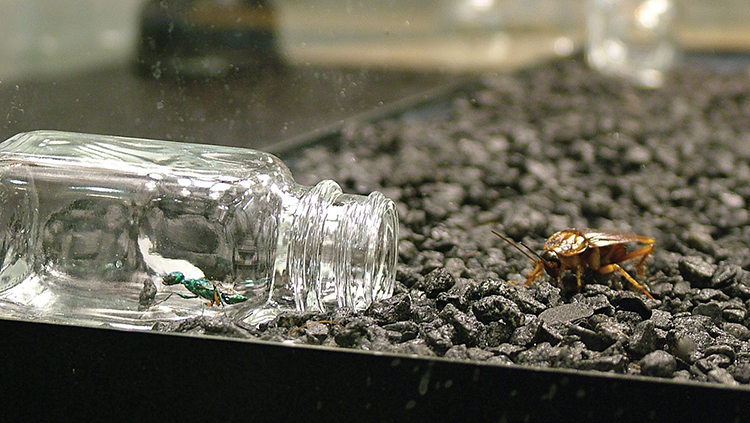 |
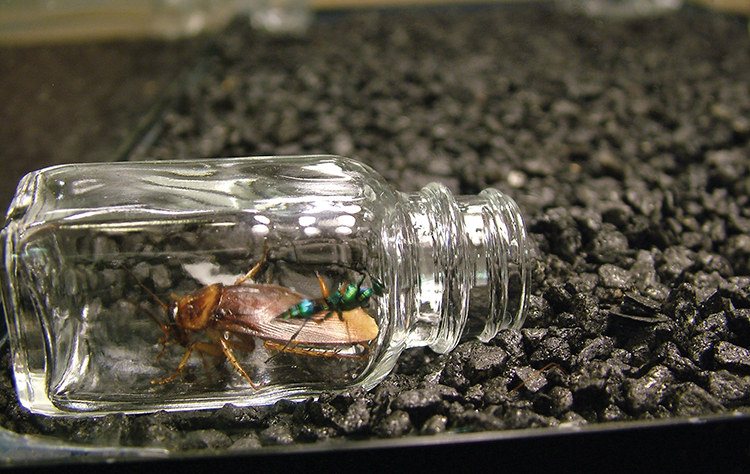 |
| The wasp prepares a burrow inside the jar for its bewitched victim. |
“It receives a sting in the thorax, its struggles become more feeble, and as the Ampulex thrusts her sting deep into its throat the head is thereby forced outwards on a membranous neck. After a few moments of injecting the poison, the wasp releases her hold and now backs off to view her work alertly. She may even grasp the cockroach and make pretense at dragging it away but usually leaves it in place — a wretched spectacle, head down and helpless though not immobile and later regaining considerable activity.”
Once the wasp has prepared a burrow and pulled the cockroach in, it glues an egg to the underside of the bug and buries it. The egg hatches, and the larva grows latched on the cockroach. Once the larva has grown its final set of mandibles, it begins to chew into the roach, eventually climbing in completely. Inside the still-living host, the larva enters the pupal stage, forms a cocoon and matures. It emerges as a fully formed wasp.
“The last pair of jaws are large and stout-toothed, and it is with these that the larva immediately bites through the cockroach’s body to enter it and feed within … The larva now feeds ravenously within its weakening host, hollowing out its body even to the base of the legs. The cockroach soon perishes – having provided the wasp during its life as a grub with a continuous supply of fresh meat.”

Francis Xavier Williams
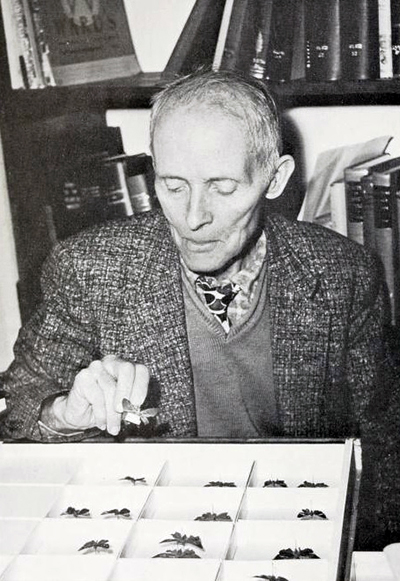 |
| Francis Xavier Williams at the San Diego Society of Natural History, about 1960, photo taken by Bucky Reeves. Photo courtesy of the Occasional Papers of the California Academy of Sciences. |
Williams contributed more to the science of entomology than just his detailed observations and illustrations of the female Ampulex hunting behavior. A globetrotter, Williams traveled through the Galapagos Islands, the United States, the Philippines, parts of Central and South America, and East Africa in his pursuit of insects.
In his expedition to the Galapagos Islands alone, between 1905 and 1906, he collected more than 4,000 insects from which scores of new species were described. Williams himself proposed 146 new taxa in three orders of Insecta, including five genera, one subgenus, 132 species, six subspecies and two replacement names.
In his career of six decades, Williams published 286 scientific papers as well as the 400-page reference book “Handbook of the Insects and Other Invertebrates of Hawaiian Sugar Cane Fields.” In 1946, Williams published a popular book, “Mike the Minah,” which he had coauthored with his wife Louisa Clark Williams. He died in California, the state where he was born, in 1967 at age 85.
Reversible effects of biomolecules are not unusual, points out Libersat. “There are things that are secreted by your own brain that can affect you for periods of weeks or months, like a woman’s menstrual cycle,” he explains. “You can imagine that there is something in the venom that has an effect that lasts for a week.”
Given the evolutionary conservation of the dopaminergic system between insects and humans, the experts think that the study of the insect system may have an impact on human illnesses, such as Parkinson’s.
“One of the hallmarks of Parkinson disease is the inability of people to generate movement. One of the treatments of Parkinson disease is to supply them with a precursor to dopamine because the dopaminergic system is malfunctioning,” says Libersat. “The dopaminergic system is involved in controlling the initiation of locomotion in insects as well.”
The wasp venom’s dopamine probably attacks the cockroach’s dopaminergic synaptic transmission. “The cockroaches show the classical freezing movements of Parkinson-disease patients,” says Libersat. “The roaches are immobile, but they can generate movement in specific conditions, such as being led by the antennae by the wasp.”

So much like scientists of yesterday, present-day scientists continue to be fascinated by the parasitic jewel wasp and her manipulative ways with her cockroach victim. As Williams described, it wasn’t just scientists who found this wasp to be a wonder to behold:
“On our Pan American Airways voyage from Nouméa to Honolulu, we stopped for a day and a half at the equatorial atoll of Canton. Here the two Ampulex jars were brought out of their travel bags, a large cockroach was given to each of the wasps, and the airplane passengers, the airplane and the ground crews were treated to an exciting rough-and-tumble performance.”

Enjoy reading ASBMB Today?
Become a member to receive the print edition four times a year and the digital edition monthly.
Learn moreGet the latest from ASBMB Today
Enter your email address, and we’ll send you a weekly email with recent articles, interviews and more.
Latest in Science
Science highlights or most popular articles

Finding a symphony among complex molecules
MOSAIC scholar Stanna Dorn uses total synthesis to recreate rare bacterial natural products with potential therapeutic applications.

E-cigarettes drive irreversible lung damage via free radicals
E-cigarettes are often thought to be safer because they lack many of the carcinogens found in tobacco cigarettes. However, scientists recently found that exposure to e-cigarette vapor can cause severe, irreversible lung damage.

Using DNA barcodes to capture local biodiversity
Undergraduate at the University of California, Santa Barbara, leads citizen science initiative to engage the public in DNA barcoding to catalog local biodiversity, fostering community involvement in science.

Targeting Toxoplasma parasites and their protein accomplices
Researchers identify that a Toxoplasma gondii enzyme drives parasite's survival. Read more about this recent study from the Journal of Lipid Research.

Scavenger protein receptor aids the transport of lipoproteins
Scientists elucidated how two major splice variants of scavenger receptors affect cellular localization in endothelial cells. Read more about this recent study from the Journal of Lipid Research.

Fat cells are a culprit in osteoporosis
Scientists reveal that lipid transfer from bone marrow adipocytes to osteoblasts impairs bone formation by downregulating osteogenic proteins and inducing ferroptosis. Read more about this recent study from the Journal of Lipid Research.

